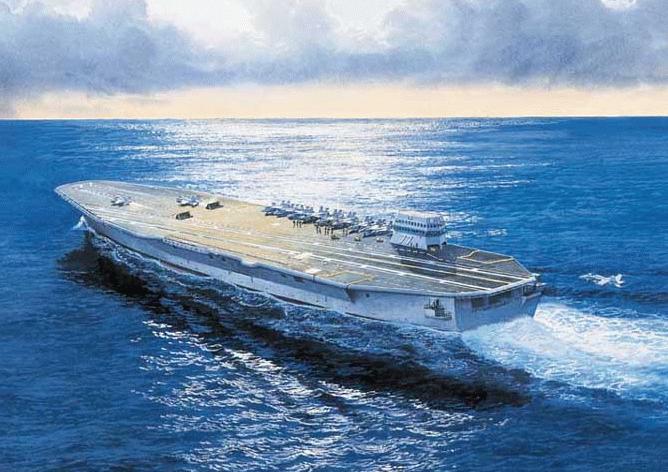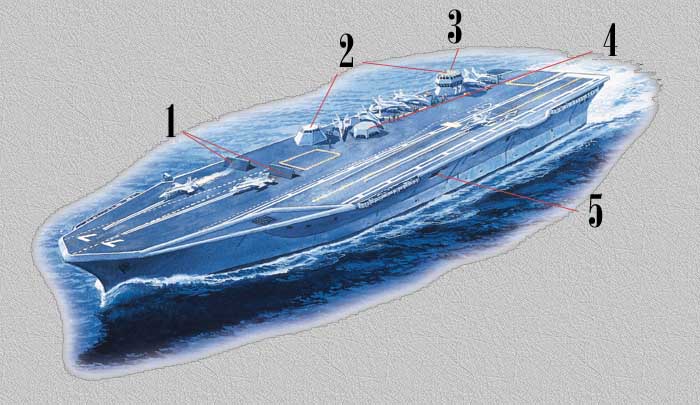



CVN-77
The Navy aircraft carrier acquisition program responds to future challenges and requirements with a two-track strategy. The near-term track of this strategy is CVN 77, the tenth NIMITZ Class and the first carrier of the 21st Century. The post-Cold War carrier force
structure includes 12 aircraft carriers, 11 in the active force and one in the reserves. To maintain this force structure, the Navy must begin construction of its next carrier, CVN-77, by fiscal year 2002 in order to complete it by fiscal year 2008. Completion in this year is necessary to replace the last conventional carrier, USS Kitty Hawk (CV-63), that will still be in service in the active force. Kitty Hawk will be 47 years old at that time.
The Fiscal Year 1998 budget request would have funded CVN-77 in the traditional manner by means of advance procurement funding of $695.0 million in fiscal year 2000, with the remaining balance of $4.5 billion included in fiscal year 2002. The previous nuclear aircraft carrier, CVN-76, was authorized in fiscal year 1995. The seven year gap between CVN-76 and CVN-77 exceeded any construction interval between individual carriers in the previous three decades, which was the six years between USS Carl Vinson (CVN-70), a fiscal year 1974 ship, and USS Theodore Roosevelt (CVN-71), a fiscal year 1980 ship.
In 1997 Newport News proposed what it termed a "Smart Buy" procurement strategy for the next Nimitz class carrier, under which a portion of CVN-77 funding originally budgeted for 2002 would be incrementally funded in FY98 through FY01. The company claimed that this advanced funding would reduce the cost of the carrier by an estimated $600 million by ensuring a strong supplier base and preserving essential shipbuilding skills that might otherwise be lost during the construction gap between CVN-76 and CVN-77.
The FY1998 budget request included no funding for CVN 77, a posture supported by the House. However, the Senate authorized $345.0 million for procurement and construction of components for the CVN 77 aircraft carrier, authorized the Secretary of the Navy to enter into a contract or contracts with the carrier shipbuilder for such purposes, and authorized $35.0 million for research, development, test, and evaluation of technologies that have potential for use in the CVN 77. The Senate directed the Secretary of Defense to structure the procurement of the CVN 77
so that the carrier is acquired for an amount not to exceed $4.6 billion.
The conferees supported construction of the CVN 77 and encouraged the Secretary of Defense to make available up to $295.0 million in fiscal year 1998 and to include in the FYDP accompanying the fiscal year 1999 budget request the funding necessary to achieve the savings required to remain within the $4.6 billion cost limitation.
CVN-77 ANNUAL FUNDING
[In millions of dollars]
-------------------------------------------------------------------------------
Fiscal year--
------------------------------------------------------- Total
1998 1999 2000 2001 2002
-------------------------------------------------------------------------------
FYDP........... 0 0 695 0 4,505 5,200
Senate......... 345 170 875 135 3,074 4,600
--------------------------------------------------------------
Difference..... +345 +170 +180 +135 -1,430 -600
-------------------------------------------------------------------------------
Responding to FY 1998 Congressional action, the Navy substantially revised the Department's SCN funding profile for CVN 77 in the FY 1999 budget submission. Including the $48.7 million provided by the FY 1998 Appropriations Act, the Department applied a total of $241 million above the advance procurement for nuclear components, for non-nuclear advance procurement and advance construction of components in FYs 1998 through 2000. With assistance in top line accommodation from the Office of the Secretary of Defense and the Office of Management
and Budget, this accelerated the full funding of CVN 77 one year to FY 2001. The resultant profile, which shortens the production gap between CVN 76 and CVN 77, will provide significant industrial base benefits and savings while balancing other shipbuilding priorities.
CVN-77 will provide a transition from the Nimitz-class nuclear aircraft carrier to the next-generation CV(X). As such, CVN-77 is a candidate for development, evaluation, and incorporation of a range of advanced technologies and acquisition reform initiatives which, not only could result in lower life cycle costs, but could also set the standard by which further improvements in the application of advanced technologies and acquisition initiatives to the design and construction of the CV(X) will be measured. Technology innovations fielded in CVN 77, which are targeted to achieve a 15% reduction in Operation and Support Costs, will also be backfit as feasible in the other nine ships of the NIMITZ Class through the Carrier Improvement Plan, and forward fit to achieve cost savings and risk reduction in the next class, CVX. The FY 1999 budget request included $38 million in RDT&E funding to support incorporation of critical transition technologies in CVN 77.


| |
Features of CVN 77 Concept
Design |
| 1 |
Passive Jet Blast Deflector: Redesigns and new materials
mean reduced maintenance costs. |
| 2 |
Island Designs: Improve flight deck access and reduce
signature and electronic self-interference. |
| 3 |
Signature Reduction: Curved flight deck edges, enclosed
antenna farms, smaller islands and internal aircraft elevators add up to maximum stealth. |
| 4 |
Aircraft Pit Stop: Semi-automated refueling and servicing in
a new configuration and deck location provides faster, more efficient airwing pit stops
and requires fewer people. |
| 5 |
Hanger Bay: New designs reduce clutter. |
Other features incorporated in this concept include:
Manpower Reductions: Technology, space
rearrangement, operational procedure changes, advanced sensor technologies and
condition-based maintenance systems all allow for a smaller, specially-trained crew.
Reconfigurable Spaces: Life-of-the-ship modular
construction designs provide flexibility and reduce cost.
Expanded Bandwidth: More onboard and offboard
capability gives the ship a communications edge.
Zonal Electrical Distribution Systems: Isolate
the potential for problems and minimizes the effect on the rest of the ship.
Automation Insertion: Material movement devices,
semi-autonomous, gravity compensated weapons handling devices, damage control automation
systems and components will reduce the ship's crew and costs.
Sources and Resources
http://www.fas.org/man/dod-101/sys/ship/cvn-77.htm
Maintained by Robert Sherman
Originally created by John Pike
Updated Friday, July 24, 1998 8:40:53 PM





